As part of the run up to SaaStr Annual in the SF Bay Area, we’re taking a look back at some of our top sessions of all times. Get tickets here.
Sam Altman, then President at Y Combinator, moderated as Josh Reeves, CEO of now $2B+ Gusto; Tracy Young, Co-founder & CEO of now almost $1B PlanGrid (acquired by Autodesk); and Spenser Skates, Co-founder & CEO at now $4B Amplitude, share their best advice, including the importance of culture and values, hiring the right people, keeping your focus on your customers and properly how to approach fundraising.
Get tickets here.
TRANSCRIPT
Moderator: YCombinator, PlanGrid, Amplitude, and Gusto are crushing it. Dropbox just hit one billion dollars in annual revenue. Stripe is valued at almost nine billion dollars.
What’s the secret to SaaS success at YCombinator? Let’s find out from Sam Altman, President at YCombinator and CEOs, Tracy Young, Josh Reeves, and Spencer Skates.
Sam Altman: Hi, I’m Sam. Thank you all for having me here. We’re going to talk to three YC founders today. We have Josh, Tracy, and Spencer joining us.
Sam: We funded all three of these companies in our Winter 2012 batch. Before we start, maybe, start with you, Josh. If you could introduce yourself and say what you do.
Josh Reeves: My name is Josh Reeves. I’m the CEO and founder of Gusto. We help over 40,000 companies today across the US with payroll, health insurance, HR.
Tracy Young: Hi, my name is Tracy Young. I’m one of the co founders and CEO of PlanGrid. PlanGrid builds beautiful, simple software for the construction industry. Since 2011, over 500,000 projects have been built with PlanGrid.
Spencer Skates: Hi all, I’m Spencer Skates. I’m CEO and co founder of Amplitude. We do product analytics to help companies build better products. We work with brands across the industry, like IBM, Disney, Intuit, Microsoft to help them build better products to understand what their users are doing.
Sam: We’re going to talk today about a lot of topics, but the general theme is, what’s the difference between good and great SaaS companies?
It’s particularly interesting for me because these are three companies that when I worked with them five years ago, they don’t look that different from any of the other companies.
Obviously, the three of you have gone on to do amazing things, and I want to talk about why, and what you’ve done that has worked really well.
People often ask in these panels, “What have you done wrong? What were your biggest mistakes?” That is interesting, but always less informative than what you really did right.
I’d like to talk about that. If you think back on the last five years, what are the two or three things that you’ve done that have really gone well, that have really worked?
Josh: We also realized we’re all in the same YC batch five years ago, so it’s a fun reunion to be here together.
I can think of two things. One, for us it was really important early on to think about why we started the company.
For us, it’s about fixing this problem, serving the customer well, so a very service driven mindset, which I gave a talk on a few days ago here, has been a big part of Gusto and affected our hiring from the early days.
It became a part of our interview questions. It became a part of how we judge success, things like NPS, part of our KPIs, as important as things like ARR.
The second is pulling more around values, and how we approached team building. Even as a three person team, we went through an exercise to figure out what do we stand for, as a team?
What is our core philosophy? What makes us unique, different? What are some of our stakes in the ground?
Then trying to maintain that as we scale is always the challenge. We’ve had to refactor that over time, but it’s something that I’m proud of today.
Sam: This is not my insight, but someone else says…. I really do believe it, that the team you build is the company you build.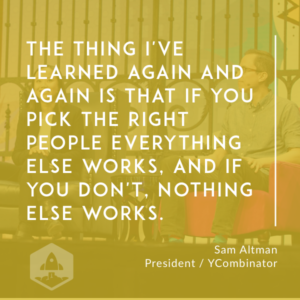
Certainly, at YC where our version of hiring is basically choosing which founders to fund. The thing I’ve learned again and again is that if you pick the right people everything else works, and if you don’t, nothing else works.
How have the other two of you thought about building out your team?
Tracy: Founders found the company, but it takes an entire team, an entire village to build and grow it. Getting the team right is so key here. It has to do with the type of people we are. It has to do with how we’re aligned.
What’s worked for us is that we’re here to build beautiful productivity tools for an industry of field workers who have never seen great software before, and we believe that they deserve it.
Because we’re so aligned at such a basic level, we can actually work productively together, and make the impossible happen.
Spencer: One of my biggest perspectives, to build on what you said, Josh, on cultures. In my mind, culture is one of these things that you discover, and it’s a function of the people that you have.
You can be like, “OK, our culture is we’re going to work super hard, and churn out a lot of features, and sell a lot of product.”
Say, “Hey, I’m going to be the dictator and set it top down.” but really, culture is one of these things that comes from the bottom up, and is set by the people.
Being really, really, really intentional about that, and dogmatic about who you hire, who you fire, how you set up the org in order to make everybody successful, what you celebrate.
That’s the one key thing. Can you hire people that are not just preserve the culture, but enhance it or build it in some ways that puts it better than wherever you could have had it.
Sam: Those were very well polished sound bites. I don’t think that answers the question of how you actually hire. If you are a founder, and you are trying to hire an executive, and you have never done it before, this is something almost everyone gets wrong.
I got it wrong many times myself. How do you actually very tactically find the person? What questions do you ask in the interview? How do you get them to join? How do you make them all not fight with each other and snipe at each other once they get there?
Spencer: This is something we screwed up a lot of different times. The first executive hire we made did not work out. Part of it is this is why. You’re in the valley, you raise venture capital.
One of the things that worked for us, at least, in terms of getting in front of the right folks was retain search firms for executives. That can definitely help.
Also, you have to figure out if they align with your values, and your mission, and your way of running things.
For example, a big thing for us is what we call ownership mindset. Are you an owner end to end and do you say, “OK, I’m going to take this problem and figure it out?”
There’s this great analogy of drivers versus passengers. Are you a driver of your company, and are you a driver of the situation you’re in, versus are you just along for the ride?
For us, definitely one big thing that we look for us is, are you a driver of the situation you’re in? Do you understand the why behind why you created this policy or this initiative or hired people in this way?
Josh: I can give a tactical example.
Spencer: That’d be great.
Josh: I made probably the first 50, 60 offers in the company personally, and that does not scale. We had to create a team where every six months we have a peer nomination process.
It’s a team that’s only focused on a values type interview process. We have a set of specific questions we ask. I do a half day training with that team.
It’s this exciting thing to become a part of. Every single candidate coming through Gusto does what we call a watermelon interview.
It’s kind of an inside joke, but basically that’s a way to scale something that we knew was important early on, but I was no longer able to go do myself.
Sam: Do you have your values written out?
Josh: We have six core values in the company. You’ll never see them on our walls, never see them on t shirts. To me, you either live your values or you don’t. I don’t think there are personal values or professional values.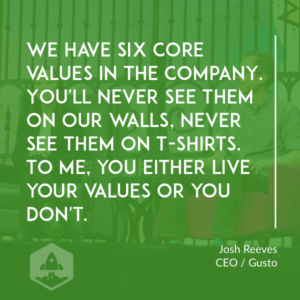
It really is more of an inward facing, introspective journey to figure out, why did you come together as a founding team, and why did you start this business in the first place?
Sam: I think writing out your values, not too early, because I agree you discover them, but I think writing them out relatively early, 10 employees, 20 employees, and then using that as…
Spencer: That’s the point we did it at…
Sam: …a guide to the hiring process works phenomenally well. I don’t know why most companies don’t do this. Do you want to tell us what yours are, by chance? Not to put you on the spot if you don’t.
Josh: Yeah, no, I definitely know them very well. Our first one is actually almost the same terminology as yours, Spencer. We call it ownership mentality. Basically, it’s a cool thing that everyone can benefit from.
When you start a tech company, you give equity to your employees. That’s not just about aligning for economic outcome. It literally makes every employee on your team an owner of the business. It affects how we run the company, how we share information. That’s the first.
The second one is “Don’t optimize for the short term.” It’s about this long term mindset, staying focused on us being around for several decades, which is going to take a lot of time for us to go fix this problem.
We are all builders. It’s about taking action. Talk is cheap. There’s a time and a place for it, but a startup, the lifeblood, is getting shit done.
We have two more ethical ones. Kind of the Boy Scout in me coming out, but it’s “Do the right thing” and “Go the extra mile.” In our business, it’s about service.
We’re doing this very mission critical task for all of our customers, paying their people on time, setting up insurance.
Then transparency really affects more how we operate. I was just talking with Tracy about how when we make offers to people, in our offer documents we list out our cash balance in our bank account.
We do that today with 440 employees. We’ve done that since day one. To us, is the right way to make an offer to someone. They should understand the state of our business.
When we do all hands meetings, we go through every KPI, every metric, ARR, margin, with every Gustee.
It affects then how we hire, because we know that someone, once they join, is going to get a lot of information, be empowered as an owner, and that’s how we run the business.
Sam: Again, to go back to the tactics of hiring executives, you write out your values. You hire a search firm.
I want to come be your VP of sales and, you’re going to meet me for the first time. What are the questions you ask, and what do you try to evaluate in that first meeting?
Spencer: For me, the key things for a VP of sales is, “OK, tell me about your best reps. How do you hire?”
If they can rattle off, “Hey, here’s my best rep. Here’s why they’re good. Here’s their motivations. Here’s what they look like. Here’s their background. Here’s their weaknesses.”
If they know that about the people that they’ve worked with before, that’s a really, really good sign.
If they don’t know it super well, that’s the first red flag and the first thing that indicates that, for example, we just went through a search for an engineering leader.
The big difference that I found between the person that we hired and everyone that we decided to reject was that the person we hired was a leader first and an engineer second.
A lot of the VP engineering candidates that we had looked at were engineers first and would talk about engineering problems, instead of talking about people or people problems first.
That was definitely a key one for us. It’s not can they be the best engineer or the best salesperson. Can they know how to find and motivate and understand what makes a salesperson tick, and explain that to you better than you know it yourself?
Tracy: I think that past experience. What are you trying to hire them for, and have they done it before? It’s as simple as that. It’s a good indicator of what they can actually do here.
Just more practically, when I meet an exec, it’s also a two way sell. We’re trying to recruit someone that’s way above our weight class, so that we can actually scale.
I like to spend 15, 20 minutes just selling, selling PlanGrid, selling the vision, getting them hooked in. Then the rest of the meeting I spend a lot of time just trying to understand why they made certain decisions that they made, what drives them.
Then, also, evaluating whether this is someone I want to spend the next few years with, building PlanGrid.
Sam: What do you do once a new executive starts to make them successful, and how do you bring them into the rest of the team?
Tracy: Go ahead.
Spencer: The key thing for me that I had to learn, and I screwed up with the first one we hired was just letting them run the team and just going totally hands off.
Obviously, you want to help and give them context and support them, but the worst is if team members can be like, “Hey, this exec is bad in this way” and go around them because they need to establish, for sure, within the first 30 to 60 days their authority with the team to make the calls.
Then you evaluate them on a longer cadence. Are they driving the team in where you want to the place that you want? For sure, that’s one of the hardest things for a lot of CEOs to let go of is control of the team and control of everything that’s going on there.
I’d hear, “Oh, the sales rep is unhappy” or “This person isn’t happy.” I’d be like, “Well, my instinct is to dig in if my people are unhappy.” But one of the reasons that you hire an exec is to empower them to do that and have full ownership of the team.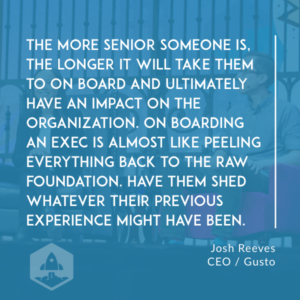
Josh: One piece of advice I have there is I was given this advice. Basically, the more senior someone is, and hopefully it’s the need you have in the company, not you just hiring them for the sake of them being a senior, the longer it will take them to on board and ultimately have an impact on the organization.
On boarding with an exec is almost like, you want to peel everything back to the raw foundation. Have them shed whatever their previous experience might have been, or whatever company they were a part of. Get down to, I’m learning about a new industry.
In our case, it’s payroll, HR. Join lots of different group sessions and then build up this knowledge base.
We found with senior execs, it’s about six months before we actually expect someone to be highly effective and impactful, but we plan around that.
We don’t expect them one month, two months, and I think that’s a pitfall, to be making really smart decisions and know how to navigate the organization. It actually takes time to give them a chance to go then be owners of the specific function they’re responsible for.
Spencer: The other thing I’ve seen that’s good from execs is that if they will beat you up as CEO and make you better. That takes a lot of humility as CEO to let that happen.
If they’re saying, “Hey, this thing in recruiting is really messed up. We got to up level. This thing on our website is messed up. This thing in the product, or how we do culture. Whatever it is, is messed up.”
That’s actually a really, really good sign, but takes a lot of humility as a CEO to say, “Hey, I hired someone who’s a better manager, leader, or operator, or whatever it is, than me.”
Sam: Tracy, to go back to the original question, what are the things that you’ve done really right?
Tracy: It feels like we are a broken record up here, but getting the right team is about recruiting the right people to the team. It’s also about identifying who the wrong fits are.
It’s always hard because you obviously didn’t hire someone stupid to the team. They’re incredibly hard working. They’re incredibly bright, but they’re just the wrong fit, and it’s not working out.
That decision to get that team right also includes making these hard decisions, and especially when there’s negativity involved.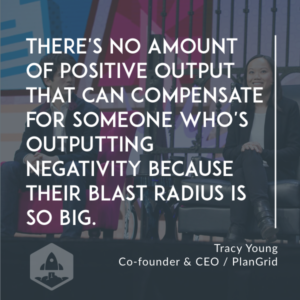
There’s no amount of positive output that can compensate for someone who’s outputting negativity because their blast radius is so big, and it actually affects the core team that is actually getting stuff done.
Getting the team right, getting the right people on the bus, the wrong people off the bus.
Josh: One thing I would add, and I really respect how PlanGrid’s done this, we were just talking about it.
It’s like, when it comes to something like strategy. I always early on wondered what people meant by that word. To me, it was vision. You have your purpose, why you exist.
If you were to talk to any of us four or five years ago, we had a pretty clear, at least, point of view on what we think the future looks like. It doesn’t mean any of it’s guaranteed, but that is a vision. That is the call to action for why we work our asses off every day.
The way to get there, the sequence, at what rate, at what speed? How do you allocate capital? Should we do it at 2, 3X per year versus 1, 2X. Being deliberate in that process, not getting caught up too much in the echo chamber.
Silicon Valley is an amazing place to live. I’ve been here my whole life, but it’s good to travel and get out of this environment, too, because it can be an echo chamber, at times, where you actually start getting caught up in hype.
I respect what you guys have done, and we’ve also been pretty good at this, of not trying to be distracted and just focus on, “Serve the customer. Do it in a way you’re proud of, and build a sound business.”
Those are actually the same ingredients any business needs to be successful.
Spencer: Sam, by the way, I feel really bad because you’re trying to get at tactics and specific examples from us, but people are one of the hardest things to talk about. We always have to kick it up level of abstraction.
Sam: No problem. People are the hardest part of this. We’ll be less abstract the rest of this. One of the great analogies that I’ve learned from Elon Musk about people is that you want to evaluate them on the net impact they have on the output vector of the entire organization.
There’s some people that are really good at their jobs, but piss everybody else off. It’s a little win, and then a bigger loss.
Tracy: That loss radius.
Sam: Yeah, but ever since I’ve heard that, it’s been a good framework for thinking about strengths and weaknesses in different people.
How many people are at each of your companies now? You said 440.
Josh: 430, 440.
Tracy: 280.
Spencer: 60.
Sam: How do you all spend your time now? I guess, since you have the largest team, we’ll start with you. What do your days look like? How do you think about time allocation?
Josh: Yeah, I’d say, I’ll go philosophy and then tactic, the goal is to be proactive, not reactive. We’ve created certain structures. I have a CEO team. It’s not a one person function, in my opinion.
I have someone that does more operations work, and then someone who works more as a chief of staff. My day to day actually depends entirely on the day. I would say I have a responsibility to my staff, the people that I directly empower and report to me.
I try to actually have, at least, half of my time, ideally be flexible, week to week, to choose and focus on the most important project or priority in the business. There’s a set of things that are always there, like PR work, fundraising, financing, investor relations work, candidates hiring, etc.
Tracy: I like keeping it simple. I try to only focus on one or two things every quarter. I feel like that’s as much as we can tackle at this point.
At the beginning, when we’re founders and we’re sub 50 people, we have to make ourselves into 10 people to even compete and get things done.
We’re manhandling all these problems. By the time we get to 100, 200 people, that doesn’t scale. For me, I look at each quarter, and I think about, “What are the two things I really want to happen?”
Q4 of last year, I was focused on recruiting, and that was the only thing I did. This quarter’s all about finishing up planning for the year and figuring out how hard we’re going to push and where we’re going to be lenient so we can set ourselves up with the priorities for each department.
Next quarter, I would love to focus on the customers, and travel, and be with our sales team, and meeting clients, and listening to them.
Spencer: For me, I won’t talk about now because it’s a little different, but the last two years has been recruiting execs. It’s like, most recently, hiring an engineering leader…
Sam: What percentage of your time?
Spencer: More than 50, more than 50 percent.
Sam: Can you talk about how that splits out? Is that reviewing candidates? Is that one on one meetings? That’s a huge amount of time.
Spencer: I don’t know. It’s a sales funnel like any other. It’s spending some time internally within the company first to understand what the needs are, who you’re trying to hire, and why, and what you want them to do.
Then it’s spending a lot of time meeting candidates, probably met upwards of 30 candidates over the course of six to nine months for the search.
Then, if I like them, and there’s a mutual fit, and connection, then we bring them on for two sets of on site interviews, which are four hours each with both me and various members of the engineering and leadership team.
Then, obviously, there’s the offer process and closing process. Before we hired that engineering leader that we did, there were four other engineering leaders that I thought we were going to hire after the process.
Two, we ended up declining on at the last minute, and two ended up declining on us at the last minute. It was going through that again and again and again.
Sam: Actually, time allocation, as the company scales, is the most important. It’s the highest payoff relative to effort to think about it upfront. Almost no one allocates their time right.
Actually, if we have a minute left at the end, I’ll answer it for myself because my own observation has been that it is the highest leveraged thing to do and almost everybody gets it wrong.
Spencer: Sam, you mean to spend time on figuring out your own allocation?
Sam: Figuring out your own time allocation, it’s an incredibly high leveraged thing to do. People are almost never proactive enough about how they do it.
I want to talk about how you think about growth. How important is it to manage the company towards growth? What have you found to be the best ways to generate growth for each of your companies? We’ll start with you, Tracy.
Tracy: There’s lots of ways to grow a company. In the beginning, when you raise VC funding, it’s very natural for investors to be like, “Just spend more money,” especially the last few years because so much money was flowing around.
I feel that the right time to spend money is when you feel it in every cell in your body that you just want to feel growth. Before that, we kept it really scrappy. We kept the ship tight.
We ended up so totally nailing product market fit because we were laser focused on the customer. This is key here for the growth of PlanGrid. We knew we wanted to build software for the field workers in construction.
We spent most of our time talking to them, understanding their pain points to a point where we pitied them. We felt so bad for their workflows that we couldn’t help but want to build software for them.
For us, it was customers and product versus playing this capital game of having as many steak dinners and three martini lunches with the sales team.
Spencer: Tracy, I totally agree. My rule for that is there’s a lot of examples both publicly and non public of companies where the VCs or the founders were like, “Grow, grow, grow,” at all costs. That ended up having to go through layoffs or whatever.
My big rule is that, if you feel solid about the state the company is in today, whether it’s people or whether it’s your customers or having a good experience, then you invest in growth.
Until you feel good about that, for example, if your customers are not having a good experience in your product, and they’re churning out, do not spend time on growth until you fix that.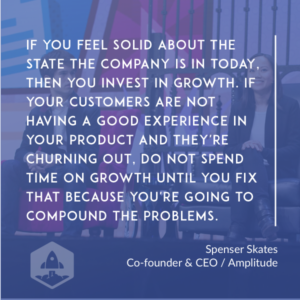
Or if your team isn’t operating well, don’t grow it, because you’re going to compound the problems.
My rule is that, if I feel good at the way things are operating and I see, “OK, hey, this is working, and I feel good about the people and everything happening,” then you can grow, but not before then.
Josh: The beauty in this room, because we’re at a SaaS conference, is that you have data to support that. Looking at cohorts, looking at basically historical behaviors, you can actually track and say, “Hey, if a put a dollar in, where does that take me over time?”
It’s about figuring out, “When are you at that stage where you feel never guaranteed that you can deploy capital in a cost effective way?” Things, like unit economics, never go away. You should always try to build a sound business.
Spencer: Retention is a better long term predictor of success than growth.
Sam: That was the thing I was going to make. YC has now funded a lot of SaaS companies. We have seen a few do incredibly well. We’ve seen a few really blow up.
The thing that is predictive of both success and failure is great retention and a high NPS in users that love a product, or a lack of that. You can definitely fake growth for a while by buying more use at the top of the funnel. It is guaranteed to fail, eventually.
It usually fails spectacularly, badly. In fact, I was going to ask a question about where you think you’ve gotten most aligned with your investors, but the place I’ve seen at the most in aggregate is investors push a company to grow and spend money to grow before the product is good enough.
Then you get into this terrible cycle where you keep having to spend more and more money to get users who think the product is worse and worse.
On that note, where have you gotten misaligned with your investors, if at all? Where do you least…?
Josh: The least alignment or most alignment?
Sam: No, no. I guess, where have your investors given you the worst advice? Or where have their interests diverged from you the most?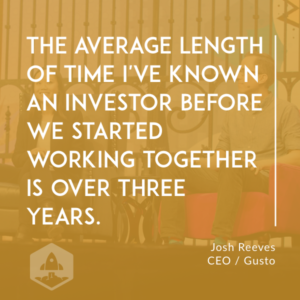
Josh: I’ll take a stab. I’ll answer both questions, I guess. One, we have a pretty unique approach. I like to go hiking with investors, get to know them. The average length of time I’ve known an investor before we started working together is over three years.
Things like values are very aligned. The important thing for any CEO or operator to realize when they’re working with their investors is that the investors have an input, but it’s your decision on how you run the business.
Understand what’s driving their motivation. In a fast growth industry, VC model is very clear. Whenever I talk to an investor, I ask, “What’s your ideal return profile? If you’re early stage, late stage, what is success? Do you want 3X return, no downside risk?
“Do you want 2 out of your 10 portfolio companies to work out? What is the way your firm is structured because there’s many ways to invest”?
We’ve gotten feedback from folks at times on, “Should we be growing faster or slower?” We have tried to take that as input, but not just say, “Hey, someone told us to do it.” Ultimately, you have to be the one running your business.
Tracy: I quite like my board directors, but we do have a lot of investors. I’d say that I get a lot of emails where they’re trying to introduce me to other investors.
It’s like I don’t need to fundraise right now, and then I still get these incoming emails of like, “You should meet this person, and you should think about fundraising.”
It’s like, “We actually don’t need to fundraise right now. We need to build up the company.” I’d say that’s probably the worst, although it’s easy enough to ignore.
Spencer: Here’s the meta thing I’ll say. I love our board members. I’m not just saying that. I actually love you guys.
Seriously, my biggest mistakes have actually come from not listening to them too much. That might be dangerous advice for a lot of CEOs and companies.
We picked the investors we did at lower prices because we felt really good about their advice and their alignment with what we were trying to do.
The high level thing is you have to really qualify and know who to listen to because, honestly, a lot of investors and a lot of advice is a total waste of time. You have to figure out, “OK, what’s the signal that you really listen to?”
For me, I go through life, and you have different coaches, so to speak, at different points and people who give you advice.
The investors and board members can be one form of that for you, if you build a good relationship and if you find the right ones. A lot of it otherwise is noise.
Sam: As always, one of the things that amazes me most about the startup ecosystem is how much terrible advice is out there.
Spencer: There’s really bad advice, Sam.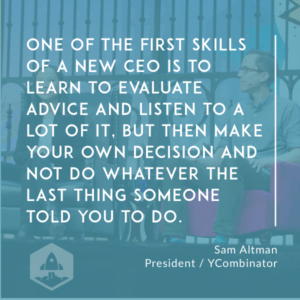
Sam: One of the first skills of a new CEO is learn to evaluate advice and learn to listen to a lot of advice, but then make your own decision and not do whatever the last thing someone told you was.
The sooner you can get through that and the sooner you decide to listen to a lot of advice, but then make your own decision and get pretty good about saying, “You know what, that actually sounds wrong and I’m not going to do it.” That’s really important.
Speaking of usually good, but sometimes bad advice, how have you all let customers drive your businesses? How do you all keep focus on customers in all the decisions you make?
Tracy: You want to go first, Josh?
Josh: Happy to. Actually, the talk I gave two days ago was all about this, too. For us, I’ll come up with a couple of examples. Metrics, again, there’s so many data points out there. Spencer knows this in his business.
Part of what they do to help you is actually focus on which metrics matter most, and it’s highly tied to your company, but definitely has something tied to customer satisfaction, customer experience, revenue retention.
We’ve had that as a key metric for us pretty much from the early days.
Two is the way you hire. We think about three things in hiring. It’s values, motivation, and skill set. When you find someone who actually really cares about the problem you’re fixing, you can tell, right?
It’s when someone who’s going to talk to their family, and this is what they’re proud of. It’s the way they helped this person, this business, this customer today. You can scale that as long as it becomes a big part of your hiring philosophy.
Those would be two things I would spotlight.
Tracy: Every company says they care about their customers, but the ones who actually really care are fewer. PlanGrid’s one of them, along with these guys here. We’re actually the users of both softwares.
It comes down to three things for us. One, we listen to them to a point where we so fully empathize with their day, their pain points.
Two, we speak their language. It helps that something like 25 percent of PlanGrid comes from an architectural engineer or a construction background.
We literally understand their jargon. We understand their workflows. We know what time they’re waking up, what time they’re hitting the job site, what their biggest fears are, and what success looks like for their work.
So that we can so fully be in their shoes that we can build product that they actually want to use and that helps them.
Three, we really love the construction industry. We deeply care about our customers. You can fake it, it’s just a lot easier when it comes from a genuine, authentic place. This job is way too hard to not be passionate about who you’re developing software for.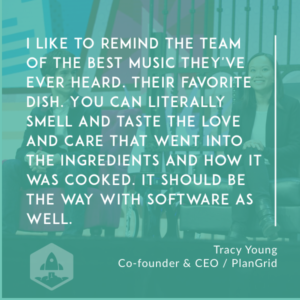
I like to remind the team of the best music you’ve ever heard. Your favorite dish. You can literally smell and taste the love and care that went into the ingredients and how it was cooked. It should be the way with software as well.
Every button is in the right place. There’s no more or no less. It does exactly what you want it to do because a team cared enough to make that happen. It’s true for the software that we’re building.
Spencer: One of the things I absolutely agree with, and what the two of you said, one of the things that we have actually is I think of…
Our head of product is actually a former customer of ours. He understands. This is going to sound crazy for me as a CEO, to say this, but he understands our product and our product story better than I do.
His job is not actually to decide what we’re going to build next in product. His job is to make the rest of the organization understand the customer and the customer story and how our product helps them in order so that all of engineering and all of product design, sales, and the rest of the company can figure out what the right things are to do to help that customer have success with Amplitude as a product.
Sam: We have about five minutes left. We’re going to do a little lightning round because I still have a lot of questions. We can do 30 second answers to these. They’re shorter ones. You don’t all have to answer.
How do you think about setting pricing?
Spencer: You have to hire someone who is an expert at it in product marketing. We are horrible at it.
Sam: How do you find the expert for that?
Spencer: That’s a whole other thing about how to hire someone in product marketing. I don’t know. We’re figuring it out right now.
Sam: Did you learn anything from your product marketing person about how to set pricing?
Spencer: We’re trying to hire. We don’t have anyone in product marketing.
Sam: You don’t have anyone.
Spencer: We’re trying to hire that person right now.
Sam: What about you two?
Tracy: This is something we’re trying to get right right now. If I could turn back time, because we’ve added so much value over the last five years and we haven’t really charged for it yet, I would probably set the price higher.
Then discount more and try to find the right price that way. It’s harder to go the other way around.
Josh: Most folks are hearing it here, hiring someone who knows pricing and packaging really well. Usually everyone makes that decision too late. Then hiring a recruiter would be the other one for me that I wish we had done earlier.
We now have gotten better at it. We have folks that have more of that background skill set, but would have liked to have spent more time on it earlier.
Spencer: Sam, one tactical thought on that. What we did from zero to one was really good, zero to one million in ARR.
You quote a super high price, and then you discount to whatever closes the deal because you’re trying to get in customers super fast. That worked really well for us.
Sam: One other takeaway is that it doesn’t matter that much because you all seemed to be fine and have a perfect answer to this.
What do you think of the funding markets for SaaS companies right now?
Tracy: What was the question?
Sam: The fundraising markets.
Spencer: I was going to ask you that question.
[laughter]
Sam: I’ll answer last. You first.
Spencer: I don’t know. They’re good, but they could always change, up or down. Who knows? I don’t know.
Back this time last year, there was a big dip which sucked because that was literally when we’d run out to do a B. I don’t know. We’re good now.
Josh: I’ll say, again, born and raised here. It operates in cycles. LinkedIn dropped 40 percent in one day last year. That’s crazy. It’s a good business.
Understand the cycle. There’s pitfalls in both parts of the cycle. You can get caught up in the froth, in the high part of it. Or you can actually, in the trough of it, be overly fearful.
Right now, it’s good for great companies. There’s lots of capital. Interest rates are low. People want to put dollars at work.
I’m personally really happy and excited that there’s always been a lot of excitement and focus on seed investing.
YC, being a part of that because, to me, you can’t over invest in seed. It’s a chance for folks to try ideas, iterate, perhaps fail, and that’s a lot of good innovation.
I would get more worried if there was a lot more froth in the Series A/B. It’s stayed pretty good over the last few years.
Sam: You don’t have to. I always try and think about where people are misaligned with me or us and where people are going to consciously or unconsciously try to deceive me.
One of the things that is very weird is that mostly people ask this question to investors. Investors are always inclined to say, “Oh, it’s really bad. It’s tough. You better take my money. You other investors better not come into the industry.”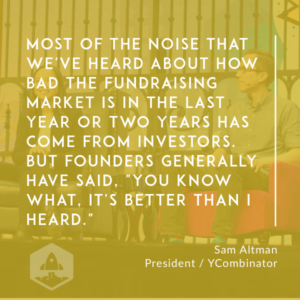
Most of the noise that we’ve heard about how bad the fundraising market is in the last year or two years has come from investors. Founders generally have said, “You know what, it’s better than I heard.”
That continues to be the case. I am very worried about a global destabilization which would have a catastrophic effect on fundraising markets and a lot of other bigger problems. For now, it seems pretty good.
New founder, founder from the Winter ’16 batch comes to you, has just gotten to a million in ARR, tries to get to 10 million over the next few years.
Spencer: Congrats.
Sam: What’s your best piece of advice about how to scale from 1 to 10 million?
Tracy: I can start. Be creative about the problem you’re solving. Be creative about what you’re building for your customers. Don’t be creative about all the business stuff.
There’s lots of companies that have done it before. Talk to them. There’s a reason there’s a sales operations teams. There’s a reason why there’s a corporate controller. Copy that playbook, and keep your creativity to where you’re innovating.
Josh: I would say get even more focused. Again, it’s easy to, as you start getting some degree of success, feel like you can now hedge a bit, do more. Actually, as you get bigger, it’s even more important to get focused.
Probably in that period, you’re going into an OKR structure. There’s lots of documentation out there. Have some way to go do budgeting, forecasting, planning.
I use the metaphor of a ski trip. You can wing it and go to Tahoe, or skiing anywhere with three people.
If you’re bringing 50 people or have millions of dollars at play, you need to actually think about what you want to do on that trip. Who’s going to do what? What’s their responsibilities?
Start building that muscle earlier. Otherwise, your planning process itself can become a liability.
Spencer: I’d say the big thing is you have to, on the advice thing, probably have to pick someone new again to talk to because the pricing advice I just gave of cut your price a lot, that only works from zero to one. To help you get from 1 to 10, you want to increase it along with a million other things.
Sam: We are about out of time. As a closing thought, I wanted to say that I know immigration has been on everyone’s mind the last few days.
The thing that has made the tech industry work and the US do as well as we have is that we have been able to get the best and the brightest people around the world.
I know that immigration is complicated. I don’t obviously support totally unregulated immigration, but I do think, for the industry that we all care about and that we’re all part of, anything that we can all do to bring the most talented people here and to be a welcoming place and a welcoming industry is super important.
[applause]
Sam: This is going to come from all of us. The big tech companies will do a lot of work, but the stories that are the most effective and really the work that eventually drives the economy is startup founders.
Please keep fighting this fight. It’s the right thing for the country and for everybody else as well. Thank you very much for coming.
Josh: Thanks, Sam.
Tracy: Thank you.

